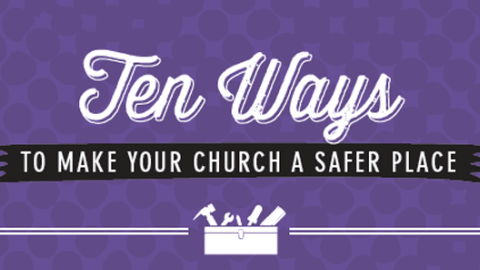Ten Ways To Make Your Church a Safer Place
2 comments
2854 views

This resource, developed by Safe Church Ministry in partnership with Faith Formation Ministries, offers congregations a helpful path towards making their churches safer.
We believe that because each person is created in the image of God, each one is to be treated with dignity and respect. Faith formation happens best in a nurturing context of healthy relationships. Safe Church Ministry equips congregations in abuse awareness, prevention, and response, helping to build communities in which the value of each person is honored and people are free to worship and grow free from abuse. Although no ministry is risk-free, there are action steps that can minimize harmful risks and prevent abuse.
We invite you to download this free resource using the pdf link below and share it with your church, or order printed copies for a small fee at FaithAliveResources.org.
1. Pay Attention to Abuse Prevention
A safe environment doesn’t happen by itself; someone needs to pay attention and take action. It’s well worth our effort! Identify a group of people in the congregation to work together to prevent abuse and create a safe environment for everyone. Make sure the group includes council representation.
2. Identify a Champion with Passion
Often abuse prevention is most effective when someone champions the effort. There are people in every congregation who have directly or indirectly experienced abuse and, as a result, may be passionate about preventing it. One of these people may agree to spearhead efforts to form a safe church team for the congregation or for the classis.
3. Connect with Thrive
It’s easy! Subscribe to our e-newsletter or browse the many resources available on The Network. You can also contact your classis safe church representative or Thrive directly (crcna.org/safechurch or network.crcna.org/safe-church).
4. Develop and Follow a Safe Church or Abuse Prevention Policy
A policy sends a strong and positive message that your church cares about the value of each and every person. Policies designed to protect those who are most vulnerable among us help to ensure a safe and respectful environment for everyone. When we don’t make the effort to have a policy, what message do we send?
5. Participate in Abuse Awareness Sunday
The fourth Sunday in September has been designated Abuse Awareness Sunday. Resources are available from Safe Church Ministry. If that Sunday doesn’t’ work, any other day is also a good day for increasing abuse awareness!
6. Implement the Circle of Grace Program
This excellent program is easily adaptable and fits with any curriculum currently being used. It’s designed to equip children and youth to be active participants in creating a safe environment for themselves and others. Everything needed is included: video training, information for parents, and vocabulary so that everyone can talk together about important relationship issues.
7. Educate Church and Ministry Leaders
Church and ministry leaders need to acknowledge that abuse exists and need to understand appropriate ways to respond to a child or adult who discloses abuse. Much harm has been done, often unintentionally, due to a lack of understanding about the dynamics and impacts of abuse.
8. Encourage and Enforce Healthy Boundaries for Ministry Leaders
Healthy boundaries provide a safe space for effective ministry. Where do pastors and ministry leaders receive boundary or ethics training? How are healthy boundaries being maintained? Are there accountability structures in place? Healthy boundaries in ministry relationships are an important key to providing a safe environment.
9. Encourage and Support Families
Much abuse happens in the home. Our efforts to support strong marriages and to teach effective parenting skills also help reduce the risks of abuse.
10. Abuse is Not Okay—But Talking about Abuse IS Okay
Establishing a culture in the congregation that allows people to be open about their struggles and what is really going on in their lives can help reduce abuse. Abuse thrives in silence and secrecy; we must not give it opportunity to thrive in our congregations.
This resource has been developed by Thrive. If you have questions or would like support in ministry, please email [email protected].
Safe Church, Leadership Development
Connect to The Network and add your own question, blog, resource, or job.
Add Your Post
Comments
http://www.careleader.org/encouraging-people-open-trauma/?utm_source=CareLeaderNewsletter&utm_medium=email&utm_campaign=CareLeaderWeeklyArticles&utm_content=incopy-textlink2-wk061-A-1-langberg&utm_campaign=website&utm_source=church_initiative&utm_medium=email
read this today and thought it helpful
Thanks for sharing this helpful article. The CareLeader newsletters often have useful information for those interested in ministry with others. Safe Church Ministry so-sponsored Trauma Healing training with World Renew last February, and we will co-sponsor another event in Canada in November. Churches can become places of healing when church members are equipped to deal with trauma that people are facing. Often we think we need to be a therapist or a professional, and sometimes that help is needed. Yet tremendously valuable to someone who is hurting is the ministry of presence, just being there with them. And a listening ear, truly listening without judgment, and without trying to "fix" someone, just listening, is a very valuable gift, that most of us are already equipped to give. May our congregations become safer places as we learn to listen to one another.
Let's Discuss
We love your comments! Thank you for helping us uphold the Community Guidelines to make this an encouraging and respectful community for everyone.